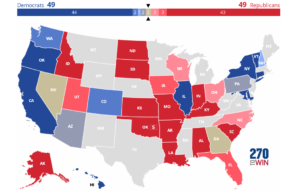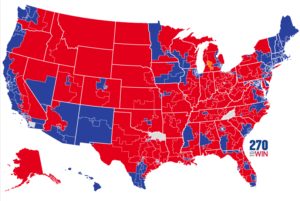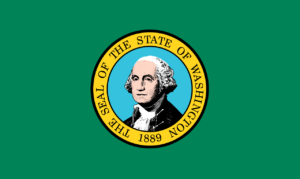As we prepare for the 2020 elections, Yesh Ginsburg and Steen Kirby will give a general overview of all 435 United States House of Representatives races. This is a basic overview to introduce you to the major candidates. All Partisan Lean numbers are taken from the Cook Partisan Voting Index. We will update this page as the races progress if anything noteworthy arises.
It’s on to California. We’ll first look at the first nine districts (in numerical order) in the state. Republicans won three of them in 2018, but only won five others in the rest of the state. If Republicans want to avoid losing even more Congressional presence in California, they need to hold these seats.
California is the most populous state in the nation, with its whopping 53 Congressional Districts. 45 of those currently sit in the hands of Democrats. Of the nine we’ll be looking at in this article, every single one is held by a Democrat. What will the Representatives be like from these districts? Let’s introduce them.
Remember, California runs on a “jungle primary” system. On March 3rd, every candidate interested in running for Congress appeared on the ballot. The top two in each race advanced to the November general election, so there are no write-ins and no third candidates. In some districts, the top two primary candidates are from the same party.
Because of California’s size, we are not putting every candidate in one article. In fact, it takes us six articles to get through all of them. This article looks over Districts 1-9, but we also have gone over all the other districts, linked below.
Districts 10-18
Districts 19-27
Districts 28-36
Districts 37-45
Districts 46-53
California’s 1st Congressional District
Incumbent: Doug LaMalfa (Republican, fourth term)
Partisan Lean: R+11
2018 Results:
| Candidate | Votes | % |
| Doug LaMalfa (R) | 160,046 | 54.89 |
| Audrey Denney (D) | 131,548 | 45.11 |
2016 Results:
| Candidate | Votes | % |
| Doug LaMalfa (R) | 185,338 | 59.02 |
| Jim Reed (D) | 128,588 | 40.98 |
Republican Candidate:
Doug LaMalfa (campaign website)
LaMalfa is relatively popular in his district, though Denney made things relatively close in 2018 and is threatening him this year. He runs on local issues, including water issues and oil prices. He is a moderate conservative on most issues, though he takes a strong stance on guns. LaMalfa does not mention President Trump on his campaign website.
Democratic Candidate:
Audrey Denney (campaign website)
Denney came up almost ten points short of unseating LaMalfa in 2018, and she’s trying again now. She has out-fundraised and outspent him so far this cycle. She is not completely in the Bernie Sanders wing of the party, though she is a strong advocate of the Green New Deal, a potentially powerful concept in a district that deals with wildfires. Denney is also very liberal on immigration, one of the starkest contrasts between her and LaMalfa. This district may eventually come into play, but probably not this cycle.
California’s 2nd Congressional District
Incumbent: Jared Huffman (Democrat, fourth term)
Partisan Lean: D+22
2018 Results:
| Candidate | Votes | % |
| Jared Huffman (D) | 243,081 | 77.01 |
| Dale Mensing (R) | 72,576 | 22.99 |
2016 Results:
| Candidate | Votes | % |
| Jared Huffman (D) | 254,194 | 76.85 |
| Dale Mensing (R) | 76,572 | 23.15 |
Republican Candidate:
Dale Mensing (campaign website)
Yesh’s notes: Dale Mensing is on his fourth attempt to unseat the popular Huffman. Why local Republicans keep voting for him, I have no idea. His campaign website is a mess of anti-liberal conspiracies, somehow claiming that Common Core is an idea taken from the Illuminati about how to turn people Communist. It’s quite a wild ride.
Democratic Candidate:
Jared Huffman (campaign website)
Huffman is a liberal Democrat in a deep blue district. And, honestly, after looking at his opponent, the platform he runs on really wouldn’t matter if this district was purple, or even slightly red.
California’s 3rd Congressional District
Incumbent: John Garamendi (Democrat, fifth term)
Partisan Lean: D+5
2018 Results:
| Candidate | Votes | % |
| John Garamendi (D) | 134,875 | 58.07 |
| Charlie Schaupp (R) | 97,376 | 41.93 |
2016 Results:
| Candidate | Votes | % |
| John Garamendi (D) | 152,513 | 59.35 |
| Eugene Cleek (R) | 104,453 | 40.65 |
Republican Candidate:
Tamika Hamilton (campaign website)
Hamilton is the best candidate that Republicans have had in this district in years. She’s campaigning on local issues, like water and homelessness, and also pushing for low taxes and a free market approach to healthcare. She also brings a life story that is both sympathetic and conducive to connecting with voters. It might not be enough to unseat an incumbent with a serious fundraising advantage, but this seat is worth keeping an eye on for now.
Democratic Candidate:
John Garamendi (campaign website)
Garamendi is a moderate Democrat whose main focus has been bringing and keeping jobs in California. He is liberal (but not a Bernie Sanders-style progressive) on issues like healthcare and the environment. Garamendi earned almost 60% in the primary, so unless Hamilton can find a way to connect to a lot of voters very quickly, he should be safe.
California’s 4th Congressional District
Incumbent: Tom Mclintock (Republican, sixth term)
Partisan Lean: R+10
2018 Results:
| Candidate | Votes | % |
| Tom Mclintock (R) | 184,401 | 54.13 |
| Jessica Morse (D) | 156,253 | 45.87 |
2016 Results:
| Candidate | Votes | % |
| Tom Mclintock (R) | 220,133 | 62.72 |
| Robert Derlet (D) | 130,845 | 37.28 |
Republican Candidate:
Tom McClintock (campaign website)
McClintock hasn’t updated his website much in the last year, which leaves it with little mention of COVID-19, but that’s a luxury that an incumbent can have. He can tell his district directly exactly what he’s doing about it, and any other issue. He is a relatively conservative Republican, with an added focus on local California issues like wildfires and Yosemite.
Democratic Candidate:
Brynne Kennedy (campaign website)
Kennedy is a very moderate Democrat, with near-conservative positions on issues like the debt, climate change, and immigration. She carries the endorsement of the Blue Dog PAC, a group supporting moderate Democrats. Kennedy is taking this race very seriously, even though McClintock won by almost ten points in 2018, and has out-fundraised and outspent him so far in the race.
California’s 5th Congressional District
Incumbent: Mike Thompson (Democrat, 11th term)
Partisan Lean: D+21
2018 Results:
| Candidate | Votes | % |
| Mike Thompson (D) | 205,860 | 78.87 |
| Anthony Mills (No party) | 55,158 | 21.13 |
2016 Results:
| Candidate | Votes | % |
| Mike Thompson (D) | 224,526 | 76.78 |
| Carlos Santamaria (R) | 67,565 | 23.22 |
Republican Candidate:
Scott Giblin (campaign website)
Giblin is a former Democrat who claims he recently moved to the Republican Party as he realized that California and government in general were becoming more repressive. He is not spending much money in campaigning, and seems to be focusing on points about corruption and duplicity in Congress rather than specific policy planks, though his policies do seem generally very conservative.
Democratic Candidate:
Mike Thompson (campaign website)
Thompson is popular in his district, never struggling to win reelection. His campaign website is out of date (parts still refer to the Republican majority in Congress), but it doesn’t really matter. He’s spending campaign funds as if he has a serious challenge, but there’s really no reason to think that he does.
California’s 6th Congressional District
Incumbent: Doris Matsui (Democrat, seventh term)
Partisan Lean: D+21
2018 Results:
| Candidate | Votes | % |
| Doris Matsui (D) | 162,411 | 80.43 |
| Jrmar Jefferson (D) | 39,528 | 19.57 |
2016 Results:
| Candidate | Votes | % |
| Doris Matsui (D) | 177,565 | 75.43 |
| Robert Evans (R) | 57,848 | 24.57 |
Republican Candidate:
Chris Bish (campaign website)
Bish is a libertarian-leaning Republican who cites Atlas Shrugged as one of her political inspirations. She is focusing her campaign towards clean water and school choice issues. The best thing going for her campaign is likely the innovative and slightly profane (and therefore potentially attention-grabbing) slogan.
Democratic Candidate:
Doris Matsui (campaign website)
Matsui first won this seat (then the fifth district) in a Special Election in 2005, and she has not faced any real challenge since. Matsui has not received under 70% of the vote in any election since 2005 (when she got 68%), including in jungle primaries. That’s an astounding history of electoral success.
California’s 7th Congressional District
Incumbent: Ami Bera (Democrat, fourth term)
Partisan Lean: D+5
2018 Results:
| Candidate | Votes | % |
| Ami Bera (D) | 155,016 | 55.04 |
| Andrew Grant (R) | 126,601 | 44.96 |
2016 Results:
| Candidate | Votes | % |
| Ami Bera (D) | 152,133 | 51.17 |
| Scott Jones (R) | 145,168 | 48.83 |
Republican Candidate:
Buzz Patterson (campaign website)
Patterson is a best-selling author who was a military aide during the Clinton administration. He was so bothered by what he saw as liberal misuse of the military that he wrote several books about it, both about Clinton and later the Obama administration. He is running a conservative campaign, mainly focusing on national security and national debt issues, connected with moving supply chains away from China. He is also in favor of term limits for Congress.
Democratic Candidate:
Ami Bera (campaign website)
Bera is an immigrant from India who very narrowly held this district since first winning election in 2012. However, in 2018 he won by almost ten points, as California has rapidly moved away from Republicans in the Trump era. He is a moderate Democrat on some issues, like small business regulations and national security. Bera is more liberal on other issues, like healthcare.
California’s 8th Congressional District
Incumbent: Paul Cook (Republican, fourth term)
Partisan Lean: R+9
2018 Results:
| Candidate | Votes | % |
| Paul Cook (R) | 102,415 | 59.97 |
| Tim Donnelly (R) | 68,370 | 40.03 |
2016 Results:
| Candidate | Votes | % |
| Paul Cook (R) | 136,972 | 62.26 |
| Rita Ramirez (D) | 83,035 | 37.74 |
Republican Candidate:
Jay Obernolte (campaign website)
Cook retired to run for the San Bernadino County Board of Supervisors, so the Republicans need a replacement to hold this seat. Obernolte is leaning hard on his accomplishments as a member of the California Assembly, essentially running an incumbent campaign in a race without an incumbent. He is relying on his business history and his economic policies to move forward in this district.
Democratic Candidate:
Chris Bubser (campaign website)
Bubser is running a standard liberal campaign, focusing more on broad Democratic Party principles than specific policy planks. She is clearly moving to not alienate right-wing voters in this Republican-leaning district, while trying to push forward with liberal principles.
California’s 9th Congressional District
Incumbent: Jerry McNerny (Democrat, seventh term)
Partisan Lean: D+8
2018 Results:
| Candidate | Votes | % |
| Jerry McNerny (D) | 113,414 | 56.49 |
| Marla Livengood (R) | 87,349 | 43.51 |
2016 Results:
| Candidate | Votes | % |
| Jerry McNerny (D) | 133,163 | 57.36 |
| Antonio Amador (R) | 98,992 | 42.64 |
Republican Candidate:
Antonio Amador
Amador almost flipped this seat in 2014, but his 2016 run was far less successful. He does not seem to have much of a campaign right now. His campaign website has been defunct since the 2014 run, and the social media is all but nonexistent. The campaign has raised and spent almost no money.
Yesh’s notes: California on the whole has moved far away from Republicans since Trump came into office, but it still seems weird that the Republicans are effectively conceding a seat they came within five points of winning only six years ago.
Democratic Candidate:
Jerry McNerney (campaign website)
McNerney is a relatively centrist Democrat who has significant detailed policy proposals throughout his website. Given the state of this race, he should have no concerns about reelection.
Overview
Republicans control three of these nine seats, and could win something around that number in November. This collection of districts should have four (maybe, but probably not, a fifth) competitive districts in the general election, which is not something you see in most of the rest of this state.
Interested in the rest of our primers for other House races? We have them all listed on our primer home page.







